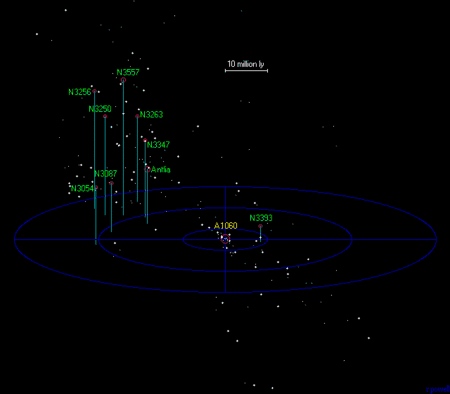Hydra–Centaurus Supercluster
The Hydra-Centaurus Supercluster (SCl 128),[2] or the Hydra and Centaurus Superclusters,[1] is a supercluster in two parts, the closest neighbour of Virgo Supercluster. It is located about 39 Mpc (127 Mly) away.[1]
| Hydra-Centaurus Supercluster | |
|---|---|
 Three-dimensional map of the Hydra Supercluster | |
| Observation data (Epoch J2000) | |
| Right ascension | 13h 14m 00.0s[1] |
| Declination | −33° 18′ 00″[1] |
| Parent structure | Laniakea Supercluster |
| Distance | ~39 Mpc (127 Mly)[2] |
| Other designations | |
| Cen-Hya Supercluster, Hydra-Cen Supercluster, Hydra-Centaurus Supercluster, SCI 128[1] | |
Physical characteristics
The supercluster includes four large galaxy clusters in the Centaurus part, also known as the "4 clusters'' filament,[3] or ''4 clusters strand'':[4]
- Abell 3526 (Centaurus Cluster)
- Abell 3565
- Abell 3574
- Abell 3581
The fliament which also inserests (sp?) the major cluster Abell S753 and exends up to around 260 Mly (80 Mpc) to reach the rich galaxy cluster Abell 3581.[3]
Antlia Wall
The Antlia Wall,[3] also known as the Antlia Strand,[5][6][4] Hydra Wall,[7] Hydra-Antlia wall, Hydra-Antlia extension,[8] and the Hydra-Antlia filament,[9] is a filament that emeges from the Centaurus Cluster, passes under the ZOA as the "Puppis filament'',[5] to link up the Lepus Cloud.[3] This filament then passes though a region containing the NGC 1600 Group before crossing the boundary where the gravitional flows of galaxies betreween the Laniakea and Perseus–Pisces superclusters diverge[5] to link up with the Perseus–Pisces supercluster at a distance of around 420 Mly (130 Mpc) from the Centaurus Cluster.[6] The fliament contains two major clusters:
- Hydra Cluster (A1060)
- Antlia Cluster (AS0636)[8]
In 2014, it was revealed that the Antila Wall along with the rest of the Hydra–Centaurus supercluster is connected to the Perseus–Pisces Supercluster.[10] Later in 2017, Pomarède et.al identified based on the flow of galaxies that the Antila Wall along with the Lepus Cloud are part of a substantial filament known as the Centaurus–Puppis–PP Filament[5] that extends around 420 Mly (130 Mpc) from the Centaurus Cluster all the way to the Perseus–Pisces supercluster.[6] The Centaurus–Puppis–PP Filament along with the Southern Supercluster Strand[5] which contains the Eridanus-Fornax-Dorado Filament and the Telescopium−Grus Cloud,[3] are part of wall that makes up the front boundary of the Sculptor Void.
Before 2017, it was not known that the Antila Wall and the Lepus Cloud were part of the same sucture, the Centaurus–Puppis–PP Filament. This is because the Centaurus–Puppis–PP Filament goes under the ZOA of the Milky Way, which caused parts of the filament to be obscured by the disk of the galaxy on the sky, resulting in the naming of the different visible pieces of filament.[5]
Other clusters
Apart from the central clusters, which are 150 to 200 million light years away, several smaller clusters belong to the group.
Within the proximity of this supercluster lies the Great Attractor, dominated by the Norma Cluster (Abell 3627). This massive cluster of galaxies exerts a large gravitational force, causing all matter within 50 Mpc to experience a bulk flow of 600 km/s toward the Norma Cluster.[11]
Laniakea
A 2014 announcement says that the Centaurus Supercluster (Hydra–Centaurus) is just a lobe in a greater supercluster, Laniakea, that is centered on the Great Attractor. That supercluster would include the Virgo Supercluster, therefore including the Milky Way where Earth resides.
See also
References
- "scl 128". simbad.u-strasbg.fr. Retrieved 2023-09-03.
- Einasto, M.; Einasto, J.; Tago, E.; Müller, V.; Andernach, H. (2001-11-01). "Optical and X-Ray Clusters as Tracers of the Supercluster-Void Network. I. Superclusters of Abell and X-Ray Clusters". The Astronomical Journal. 122 (5): 2222–2242. arXiv:astro-ph/0012536. Bibcode:2001AJ....122.2222E. doi:10.1086/323707. ISSN 0004-6256. S2CID 16129925.
- Courtois, Hélène M.; Pomarède, Daniel; Tully, R. Brent; Hoffman, Yehuda; Courtois, Denis (2013-08-14). "Cosmography of the Local Universe". The Astronomical Journal. 146 (3): 69. arXiv:1306.0091. Bibcode:2013AJ....146...69C. doi:10.1088/0004-6256/146/3/69. ISSN 0004-6256. S2CID 118625532.
- Shaya, Edward J.; Tully, R. Brent; Pomarède, Daniel; Peel, Alan (2022-03-01). "Galaxy Flows within 8000 km s−1 from Numerical Action Methods". The Astrophysical Journal. 927 (2): 168. arXiv:2201.12315. Bibcode:2022ApJ...927..168S. doi:10.3847/1538-4357/ac4f66. ISSN 0004-637X.
- Pomarède, Daniel; Hoffman, Yehuda; Courtois, Hélène M.; Tully, R. Brent (2017-08-10). "The Cosmic V-Web". The Astrophysical Journal. 845 (1): 55. arXiv:1706.03413. Bibcode:2017ApJ...845...55P. doi:10.3847/1538-4357/aa7f78. ISSN 0004-637X.
- Shaya, Edward J.; Tully, R. Brent; Hoffman, Yehuda; Pomarède, Daniel (2017-12-04). "Action Dynamics of the Local Supercluster". The Astrophysical Journal. 850 (2): 207. arXiv:1710.08935. Bibcode:2017ApJ...850..207S. doi:10.3847/1538-4357/aa9525. ISSN 1538-4357.
- Fairall, Anthony P. (1998-01-01). "Large-scale structures in the universe". Large-Scale Structures in the Universe / Anthony P. Fairall. New York : Wiley. Bibcode:1998lssu.conf.....F.
- Kraan-Korteweg, R. C.; Fairall, A. P.; Balkowski, C. (1995-05-01). "Extragalactic Large-scale structures behind the southern Milky Way.I. Redshifts obtained at the SAAO in the Hydra/Antlia extension". Astronomy and Astrophysics. 297: 617. arXiv:astro-ph/9411089. Bibcode:1995A&A...297..617K. ISSN 0004-6361.
- Kraan-Korteweg, R. C.; Cayette, V.; Balkowski, C.; Fairall, A. P.; Henning, P. A. (1994). "1994ASPC...67...99K Page 99". Unveiling Large-Scale Structures Behind the Milky Way. 67: 99. Bibcode:1994ASPC...67...99K. Retrieved 2023-09-03.
- Tully, R. Brent; Courtois, Hélène; Hoffman, Yehuda; Pomarède, Daniel (2 September 2014). "The Laniakea supercluster of galaxies". Nature (published 4 September 2014). 513 (7516): 71–73. arXiv:1409.0880. Bibcode:2014Natur.513...71T. doi:10.1038/nature13674. PMID 25186900. S2CID 205240232.
- Plionis, Manolis; Valdarnini, Riccardo (March 1, 1991). "Evidence for large-scale structure on scales about 300/h MPC". Monthly Notices of the Royal Astronomical Society. 249 (March 1, 1991): 46–61. Bibcode:1991MNRAS.249...46P. doi:10.1093/mnras/249.1.46.